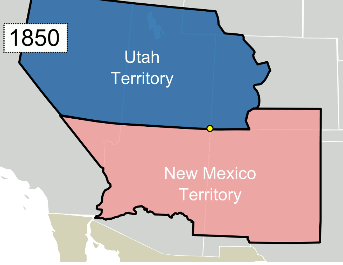Deseret: The Original LDS State
One man's "divine revelation" led to an exodus, a statehood movement and even a brief war.

Birthed From The Burned-Over District
Joseph Smith formally organized The Church of Jesus Christ of Latter-day Saints (originally named the Church of Christ) in an area of western New York known as the “burned-over district.” In the early 19th century, this region of New York along the Erie Canal was seeing a boom in industrialization alongside a scarcity of established clergymen. This led to the emergence of several new religious movements, many of which relied on fanciful aspects of folk religion like divine revelations, superstition and witchcraft to inspire converts. These movements spread like wildfire throughout the region and quickly generated an anti-religious backlash.
Barely a year after establishing the church, Smith announced that he received a divine revelation, ordering him to establish a new home for the church in Missouri. The church and its converts quickly moved out of western New York and settled just outside of Kansas City.
The Mormon War of 1838
The Mormon church was not met kindly when settling in Missouri. As the area became flooded with followers of the church, existing settlers bristled at the deeply held convictions of their new neighbors. Ideals espoused by the Mormon church were directly at odds with existing Missourians for a plethora of reasons:
Mormons believed they had a divine right to the land of their new home and called those who already lived their “enemies.” The Book of Mormon explicitly states, “If ye are faithful, ye shall assemble yourselves together to rejoice upon the land of Missouri, which is the land of your inheritance, which is now the land of your enemies.”
Due to its northern roots, the church took an abolitionist stance toward slavery. This was at odds with the political leanings of their new home as Missouri was a slave state.
The church provided communal cohesion that upended local economies, leading to the decline of local businesses who stood at odds with the church.
Since Missourians saw Mormons as invaders who aimed to upend their current way of life they reacted with hostility and violence, eventually leading to the Mormon War of 1838. The war was kicked off when Missouri polling officials campaigned to disenfranchise Mormon voters, leading to the Election Day Battle at Gallatin on August 6, 1838. Tensions continued to escalate with the Battle of Crooked River and finally culminated in the Mormon Extermination Order, issued by the Missouri Governor.
Establishing Deseret

After being expelled from Missouri, church members endured a mass exodus to the west as they continued to face discrimination and hostility when searching for a new place to establish the church. After the death of Joseph Smith in 1844, Brigham Young assumed control of the church and led the mass migration toward the Great Basin.
Mormons reached the Great Basin at the tail end of the Mexican-American War, just as Mexico ceded 529,000 square miles of land to the United States. The church leapt at the opportunity to establish its own government after settling in the Salt Lake Valley and attempted to incorporate much of the Great Basin as the Territory of Deseret.
The Territory of Deseret, had it been incorporated, would have captured all land between the Sierra Nevada and the Rocky Mountains, stretching as far north as southern Oregon. That means the territory would have swallowed all of present-day Nevada and Utah, as well as portions of Arizona, California, Colorado and New Mexico. Its major cities would include San Diego, Phoenix, Las Vegas and Salt Lake City.
The Deseret movement failed primarily due to Brigham Young’s pivot to apply for incorporation as a full-fledged state, rather than a territory. He quickly commissioned a council of church leaders to draft a state constitution and sent a delegate to petition the cause in front of Congress. Congress eventually decided against establishing the Territory of Deseret (largely due to reservations surrounding Mormon’s support of polygamy), and instead addressed the established new boundaries through the Compromise of 1850. This bisected the proposed Territory of Deseret along the 37th parallel, with lands to the south becoming New Mexico Territory and lands to the north becoming Utah Territory. Brigham Young became the Utah Territory’s first governor following its recognition by Congress.

After becoming a territory, the Deseret movement powered forward with attempts to establish statehood within the new territory’s boundaries. After multiple failed attempts in the late 1800s, the movement was effectively silenced with the introduction of railroads across the west. Prior to the construction of railroads, a large proportion of the territory’s settlers identified with the Mormon church. New arrivals were decidedly less religious and eventually eroded support for the Mormon church’s vision for state government. The Mormon church’s embrace of polygamy continued to be a sticking point for opponents of the church in federal government and eventually led to the demise of the Deseret movement. Congress requested that Utah Territory explicitly condemn the practice in its constitution if it wanted to be admitted into the Union. The territory drafted a new constitution with an explicit ban on polygamy and Utah was officially granted statehood in January 1896.


